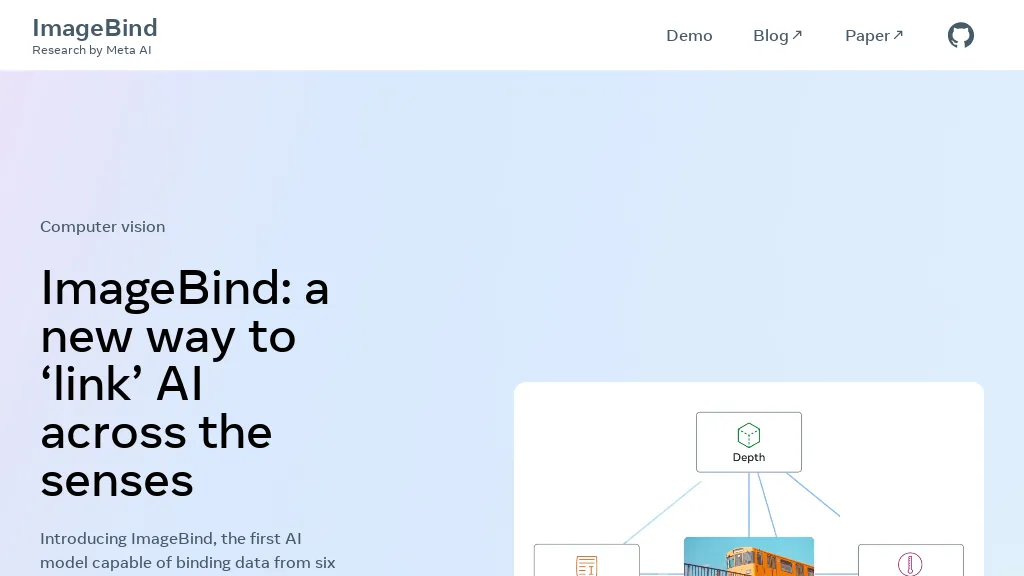What is ImageBind?
ImageBind refers to the more advanced AI tool from Meta AI, which changes how data across sensory modalities are linked. It integrates, in total, six of the data types mentioned above, which include images, videos, audio, text, depth, and thermal IMUs, without explicit supervision.
It binds these multiple sensory inputs into one embedding space, totally avoiding explicit supervision. It empowers existing AI models to run on all six modalities, enables audio-based search, cross-modal search, multimodal arithmetic, and cross-modal generation.
Key Features and Advantages of ImageBind
Advanced in multimodality: It can easily combine data from several modalities and provide holistic analysis.
User-Friendly Interface: It makes complex AI interactions easy to use for all types of users.
Innovative Algorithms: It uses cutting-edge technology to provide improved performance and accuracy.
Seamless Data Compatibility: The technology ensures coherent integration between different data types, thereby leading to better manipulation and interpretation of the data.
Meta AI Technology: It is based on a reliable and pioneering framework that gives strength and reliability to Meta AI.
It puts ImageBind at the top of the hottest choices among pros and enthusiasts, helping a project realize its potential through advanced AI capabilities.
Use Cases and Applications of ImageBind
ImageBind can be used in a variety of cases, including but not limited to the following:
- Up-grading Existing AI Models: Upgrade existing AI models to support inputs from all six modalities.
- Audio-Based and Cross-Modal Search: One is now able to perform sophisticated searches across different media types.
- Zero-Shot Recognition Tasks: State-of-the-art performance in emergent recognition tasks on multiple modalities.
It industries and sectors that use ImageBind include Data science, machine learning, artificial intelligence, computer vision, natural language processing, and robotics. It shows effectiveness in these areas through the case studies and success stories.
How to Use ImageBind
Following steps describe using ImageBind in an easy way. The process is user-friendly:
- Access the ImageBind platform Log into your account.
- Upload your data, be it images, audio, text, videos, or other supported modalities.
- Then, select the kind of analysis you would like to make, for example, cross-modal search or zero-shot recognition.
- Run the Analysis and see the results shown in the output window in a very clear and self-explanatory way.
- For best practices, remember to always keep your data organized and correctly labeled.
- Take some time to learn the UI so that you can harness its power.
How ImageBind Works
ImageBind works based on a sophisticated framework devised by Meta AI. It makes use of innovative algorithms to create one embedding space from these very different sensory inputs. This is done in a self-supervised manner, hence avoiding the use of explicit supervision, thereby making the process efficient and less labor-intensive.
It ingests data from several modalities and processes the same through sophisticated algorithms to produce a unified representation for various tasks like cross-modal searches and multimodal arithmetic.
Pros and Cons of ImageBind
Pros:
- In-depth Analysis: Integrates multiple data types for thorough insights.
- User-Friendly: Easy to use, with an interface operational by all.
- Versatility: Applies in all scenarios and industries.
- State of the Art: Excels in zero-shot recognition tasks.
Cons:
- Learning Curve: Initial setup and familiarization can get a little challenging for some users.
- Resource-Intensive: The Program is very computationally resource-intensive to perform at its best.
Most users who reviewed this product reported it to be efficient and easy to use, but some of them mentioned that the hardware should be powerful to use it to its full potential.
Conclusion about ImageBind
ImageBind by Meta AI is a state-of-the-art tool able to leverage sophisticated multimodal capabilities in the integration of data types for a holistic approach in their analysis. The intuitive interface and novel algorithms make this tool very applicable to a wide variety of uses across many industries.
As the AI technology further evolves, so will the additions of more advanced features and enhancements that will be brought into ImageBind, further solidifying its position as a leading platform for AI-driven data analysis.
ImageBind FAQs
Frequently Asked Questions:
-
What modalities does ImageBind support?
ImageBind supports modalities such as images, videos, audio, text, depth, and thermal IMUs. -
Is ImageBind beginner-friendly?
Yes, it has a user-friendly interface; thus, all users irrespective of any level will find it accessible. -
How many pricing options does it have?
ImageBind has both free and premium options since it is based upon the freemium business model.
Quick Troubleshooting Hacks:
- Ensure that your data is good; poor-quality data will only bring in poor results. Be sure that your data is organized and labeled properly.
- Check System Requirements: Ensure that your hardware specifications are such that they support the efficient running of ImageBind.
- Consult the Documentation: Go through official documentation to know in detail how to use, and tips on using ImageBind.










